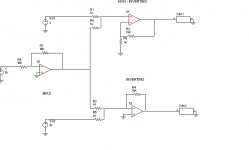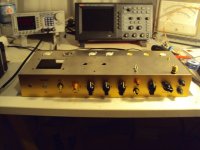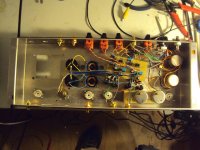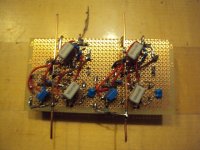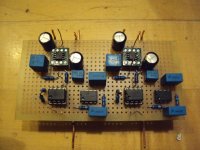First you need a constant current source. That could be a J-Fet with source resistor or a current mirror for example. I assume that the cartridge has then to be AC coupled into the phono amplifier. The most easy way would be to use a good Opamp. If that works we could construct a discrete solution. Concerning the tone controls a strain gauge cartridge does not need much equalization because it has a 6dB/oct falling response by itself. That does not work 100% perfect so you can use your tone controls for fine tuning.
The most easy way would be to use a good Opamp. If that works we could construct a discrete solution. Concerning the tone controls a strain gauge cartridge does not need much equalization because it has a 6dB/oct falling response by itself. That does not work 100% perfect so you can use your tone controls for fine tuning.
+++++++++++++++++++++++++++++++++++++
Sorry the name confusion herr Gerhard,
From the beginning I had in mind to use a coupling cap of > 3.3uf.
Response curve on this link, pg 21
http://www.vinylengine.com/turntable_forum/viewtopic.php?f=19&t=28750&hilit=28750&start=300
Do I need a delicate preamp, because of the relative high impedance 1000 ohm cart? The 3mV output is like a MM. Do you have a "simple amp" for this cart? I cannot make a choice. I like BJT s.
I want to use a good PSU like from LCaudio.
Thanks
Thanks hr Gerhard, that is a quick reply, I like this circuit from the first moment.Here is a first sketch.....
Fantastic, fantastic those BC 550/560 from the seventies, low noise, my REVOX sits full of them.
Yes, that should work and do not forget to reduce R6 to 800 Ohm. We need 4 V over the 1kOhm for 4mA. Interesting plot you send me. The cartridge has a presence drop and too much upper frequencies. I have not seen that before. In the deeper ranges that looks fine. The 1kOhm of the cartridge is not that uncommon and close to an MM. I have setup the Opamp stage so that not much noise is added. It has approximately a gain of 70 as you requested. I like to use BC560C in the mirror because they have high Hfe. Noise is more controlled by the emitter resistors but they are high enough so that the mirror does not inject much noise. You can use 3.3uF instead of 1uF. That will extend the bass somewhat but even a 1uF into 47kOhm goes to less then 20Hz.
I use the LC Audio PSU sometimes. It has only plus-minus 13V max. so you have to adjust R3, R6 proportionally. In Flavios stage i can not see how he generates the bias and where the cartridge is connected. In all the circuits i have searched on the web this part is left out as if it where a big secret only for the initiated. Maybe i have now broken the law.
Also Flavio generates a difference signal. Are the outputs of the cartridge out of phase or is that for Quadrophonia ?
Also Flavio generates a difference signal. Are the outputs of the cartridge out of phase or is that for Quadrophonia ?
Attachments
Panasonic strain gauge cartridge
I use the LC Audio PSU sometimes. It has only plus-minus 13V max. so you have to adjust R3, R6 proportionally. In Flavios stage i can not see how he generates the bias and where the cartridge is connected. In all the circuits i have searched on the web this part is left out as if it where a big secret only for the initiated. Maybe i have now broken the law.
Also Flavio generates a difference signal. Are the outputs of the cartridge out of phase or is that for Quadrophonia ?
I want not use Flavios schematic,
In the Panasonic SE-405 preamp each signal is amplified by its own frontend, and only the LEFT channel is reversed by a phase splitter TR401, but furtheron TR509 stage looks as a phase splitter, but between collector and emitter, a signal coming from the subcarrier/demodulator injects a signal there.
Is there a reversal again, I do not know.
Link here:
http://members.cox.net/noffour/quad/cd4_se405_scheme1.bmp
http://members.cox.net/noffour/quad/cd4_se405_scheme2.bmp
Web says, reverse left channel, assume for stereo use, I am not sure now.
I think I can reverse one channel of your SG schematic by changing from non-inv to inverting input, correct? If needed afterwards. Otherwise I should use separated supplies for the SG s, and reverse from there.
I use the LC Audio PSU sometimes. It has only plus-minus 13V max. so you have to adjust R3, R6 proportionally. In Flavios stage i can not see how he generates the bias and where the cartridge is connected. In all the circuits i have searched on the web this part is left out as if it where a big secret only for the initiated. Maybe i have now broken the law.
Also Flavio generates a difference signal. Are the outputs of the cartridge out of phase or is that for Quadrophonia ?
I want not use Flavios schematic,
In the Panasonic SE-405 preamp each signal is amplified by its own frontend, and only the LEFT channel is reversed by a phase splitter TR401, but furtheron TR509 stage looks as a phase splitter, but between collector and emitter, a signal coming from the subcarrier/demodulator injects a signal there.
Is there a reversal again, I do not know.
Link here:
http://members.cox.net/noffour/quad/cd4_se405_scheme1.bmp
http://members.cox.net/noffour/quad/cd4_se405_scheme2.bmp
Web says, reverse left channel, assume for stereo use, I am not sure now.
I think I can reverse one channel of your SG schematic by changing from non-inv to inverting input, correct? If needed afterwards. Otherwise I should use separated supplies for the SG s, and reverse from there.
strain gauge cartridge
Thanks, yes 2 amps
Cart has the conventional 4 pins.
Did some web search about Left channel phasing, only left channel has DC reversal, AC signal goes to +inv or -non-inverting
Did some research, yes Flavio81 again, only Left channel is DC reversed, each AC signal goes to the +noninverting or -inverting input, (both amps)
Link:
http://ns1.audiokarma.org/forums/showthread.php?t=346476&highlight=left+cannel&page=6
External SG supply is used here
Assume the stereo version is ment here
Thanks, yes 2 amps
Cart has the conventional 4 pins.
Did some web search about Left channel phasing, only left channel has DC reversal, AC signal goes to +inv or -non-inverting
Did some research, yes Flavio81 again, only Left channel is DC reversed, each AC signal goes to the +noninverting or -inverting input, (both amps)
Link:
http://ns1.audiokarma.org/forums/showthread.php?t=346476&highlight=left+cannel&page=6
External SG supply is used here
Assume the stereo version is ment here
Last edited:
Thanks, yes 2 amps
Cart has the conventional 4 pins.
Did some web search about Left channel phasing, only left channel has DC reversal, AC signal goes to +inv or -non-inverting
Did some research, yes Flavio81 again, only Left channel is DC reversed, each AC signal goes to the +noninverting or -inverting input, (both amps)
Link:
http://ns1.audiokarma.org/forums/showthread.php?t=346476&highlight=left+cannel&page=6
External SG supply is used here
Assume the stereo version is ment here
Another link, SG stereo opamp
AudioKarma.org Home Audio Stereo Discussion Forums
I finished the prototype of the Fast Audio Tanzmusik Phonostage. More information soon.
Attachments
A lot, true. Maybe i designed 400 and build 100 over the last 2 1/2 years. The interesting thing is when i look back what i did i find new ways to use old ideas. The Tanzmusik is based on an older partly inductive design of mine that i published maybe 2 years ago. Because the RIAA is based on simple multiplications i can vary the bass from around 1100usec to 5900us and the treble from 10usec to 110usec with special designed potmeters without changing the inductors or caps. That way it has a kind of tone control that can mimic other EQ´s then RIAA or simply can be used to taste. This one should also work well with your IO because it has a very high quality PCOCC input transformer.
It is VERY quiet.
It is VERY quiet.
A lot, true. Maybe i designed 400 and build 100 over the last 2 1/2 years. The interesting thing is when i look back what i did i find new ways to use old ideas. The Tanzmusik is based on an older partly inductive design of mine that i published maybe 2 years ago. Because the RIAA is based on simple multiplications i can vary the bass from around 1100usec to 5900us and the treble from 10usec to 110usec with special designed potmeters without changing the inductors or caps. That way it has a kind of tone control that can mimic other EQ´s then RIAA or simply can be used to taste. This one should also work well with your IO because it has a very high quality PCOCC input transformer.
It is VERY quiet.
I like your EQ idea. Think to use it for my EPC sg cartridge front-amp I have to built.
Strain Gauge Phono Simple.TSC - TINA.pdf
This EQ has to take place in a second amp, am I right?
Can you do that sort of EQ also for the mid range center Fr = 3 kHz?
Here is some information about EQ :
Simple, Easy Parametric and Graphic EQ's, Plus Peaks and Notches
Simple, Easy Parametric and Graphic EQ's, Plus Peaks and Notches
